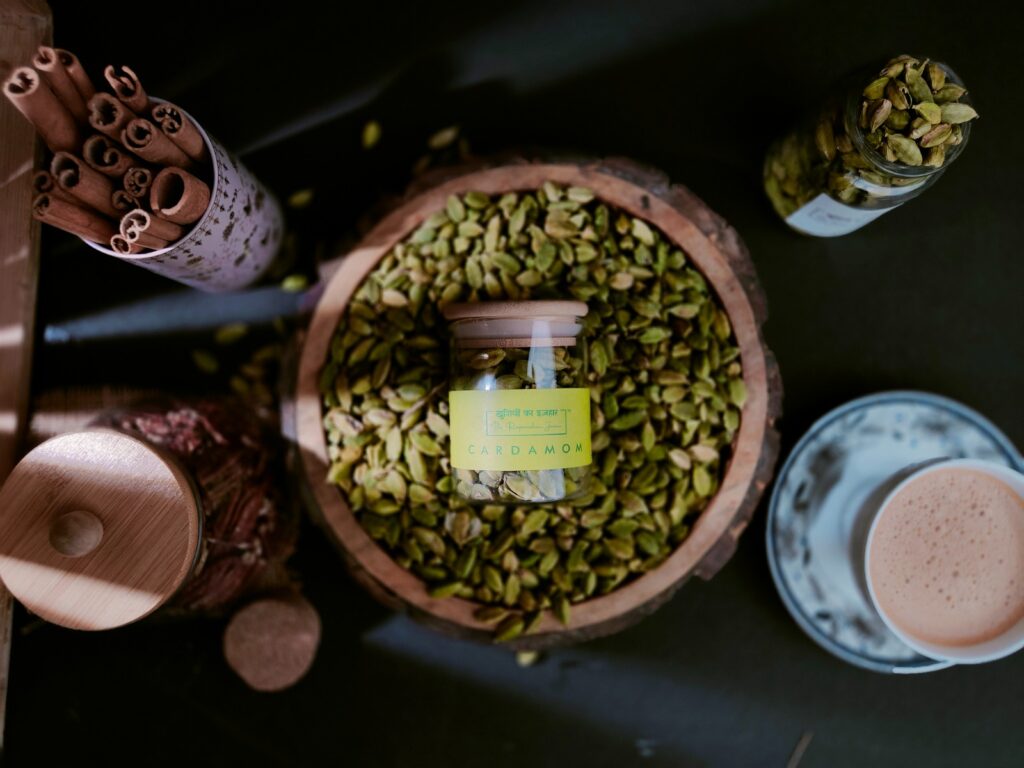Cardamom, the aromatic and versatile spice, has been an integral part of human history for millennia. Revered for its delightful fragrance, distinct flavour, and numerous health benefits, cardamom has left an indelible mark on culinary traditions, ancient medicine, and international trade. In this comprehensive blog, we will explore everything there is to know about cardamom, from its origin and various types to its diverse uses, health benefits, and delectable recipes that showcase the spice’s extraordinary potential.
The History and origin of cardamom
The history of cardamom can be traced back to ancient civilizations like Egypt, where it was used in incense and perfumes. Its origin lies in the lush, tropical regions of South India, Sri Lanka, and Southeast Asia, where it thrives in the shade of towering rainforests. Arab traders brought cardamom to the Middle East centuries ago, turning it into a highly sought-after commodity along the ancient spice route. The spice eventually found its way to Europe and the rest of the world, where it quickly gained popularity for its unique flavour and medicinal properties.
Types of cardamom
For the unversed, cardamom is found in two types, black and green cardamom. Green cardamom is known and referred as real cardamom. Green cardamom scientifically known as Elettaria cardamomum is the most common and widely used variety, known for its vibrant green pods and a pleasant, herbal-citrus aroma. Green cardamom is often used in sweet and savory dishes, teas, and desserts, imparting a subtle, refreshing taste.
Black Cardamom (Amomum subulatum):
Larger and darker than its green counterpart, black cardamom has a smoky, earthy flavor with hints of camphor. It is a staple in many Indian and Asian savory dishes, particularly in curries and meat-based recipes, adding depth and complexity to the flavors.
Interesting facts about cardamom
- Cardamom is among the most exotic and expensive spices of the world, standing along with saffron and vanilla.
- The botanical family of cardamom can be traced back to same botanical family as that of ginger and turmeric.
- It is among one of the oldest spices of world as the history of cardamom can be traced back to more than 4, 000 years.
- For centuries it is referred to as the ‘Doctor of Spices’ as the medicinal use of cardamom can help reduce several medical problems
- It is also related to secret of long life as per the belief of Chinese when consumed as cardamom tea.
- Cardamom was thought to have mystical properties in antiquity, including the ability to ward off evil spirits.
Cardamom and its different names
- Hindi – Elaichi
- French- Cardamome
- German – Kardamom
- Italian – Cardamomo
- Latin- Amomum
- Finnish- Kardemumma
- Turkish- Kakule
- Hawaiian: Kaleka Kaleka
- Malay: Buah Pelaga
- Vietnamese: Thao Qua
- Zulu: Ikhadiamom
Culinary uses and recipes of cardamom
Cardamom’s culinary applications are as diverse as its history. From premium spice blends to comforting desserts, it can transform ordinary dishes into extraordinary delights. Here are some popular recipes:
- Cardamom Chai Latte
Aromatic and soothing, this Indian-inspired spiced tea combines black tea, milk, honey, and a generous pinch of ground cardamom:
Ingredients:
- Water
- Star anise
- Cardamom pods, were later used as ground cardamom.
- Cinnamon
- Black tea bags
- Milk
- Sugar as per your taste
- Swedish Cardamom Buns (Kardemummabullar):
These delectable pastries feature a buttery dough infused with cardamom and are typically enjoyed with coffee or tea:
Ingredients:
- 1¼cups/300 milliliters whole milk
- 2¼teaspoons active dry yeast
- 4cups/510 grams unbleached all-purpose flour
- ¼cup plus 3 tablespoons/90 grams granulated sugar
- 6tablespoons/85 grams unsalted butter (¾ stick), softened.
- 2tablespoons ground cardamom
- 1teaspoon fine sea salt
- 250 grams unsalted butter
- Cardamom-Spiced Rice Pilaf:
Fragrant basmati rice cooked with whole cardamom pods, cinnamon, and other spices, creates a delightful side dish:
- 1 tbsp light olive oil
- 10 green cardamom pods, bruised.
- 1 large brown onion finely chopped.
- 1 tsp finely chopped fresh ginger.
- 1/2 tsp ground cumin
- Pinch ground turmeric
- 250g (1 1/4 cups) basmati rice
- 1 tbsp chopped fresh coriander.
- Salt & ground black pepper, to taste.
Health Benefits of Cardamom:
Beyond its culinary appeal, cardamom boasts an array of health benefits. Cardamom is used by people for its medicinal properties. Antibacterial and anti-inflammatory phytochemicals are included in it. The benefits of cardamom may also improve dental and cardiovascular health.
Let us find out some of the special health benefits of cardamom:
- Digestive Aid
Cardamom has carminative properties that help alleviate digestive issues like bloating, gas, and acidity.
- Anti-inflammatory and Antioxidant:
The spice is a rich source of antioxidants, which combat free radicals and reduce inflammation in the body.
- Oral Health
Cardamom’s antimicrobial properties can promote oral hygiene and combat bad breath.
- Respiratory Health:
Its aromatic compounds may help relieve respiratory congestion and improve breathing.
- Heart Health
Cardamom may help lower blood pressure and improve overall heart health.
Other uses of cardamom:
Apart from its culinary and medicinal uses, cardamom finds applications in various industries:
Perfumery:
Cardamom’s charming fragrance makes it a popular ingredient in perfumes and scented products.
Ayurveda and Traditional Medicine:
The spice has been used in traditional medicine systems like Ayurveda for its healing properties.
Aromatherapy:
Cardamom essential oil is employed in aromatherapy to promote relaxation and reduce stress.
To wrap it up:
Cardamom, a spice with an illustrious past and an aromatic future has delighted humanity for centuries. Its rich history, diverse types, delightful recipes, and numerous health benefits make it a truly remarkable treasure in the world of spices. From kitchens to medicine cabinets and beyond, cardamom’s influence is undeniable, making it an essential addition to any spice collection and a fragrant journey through time and cultures.


